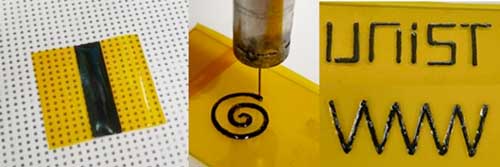| Posted: Sep 26, 2017 |
Researchers develop wearable solar thermoelectric generator
(Nanowerk News) A recent study, led by Professor Kyoung Jin Choi in the School of Materials Science and Engineering at UNIST has introduced a new advanced energy harvesting system, capable of generating electricity by simply being attached to clothes, windows, and outer walls of a building (Nano Energy, "Wearable solar thermoelectric generator driven by unprecedentedly high temperature difference").
|
|
This new device is based on a temperature difference between the hot and cold sides. The temperature difference can be increased as high as 20.9°C, which is much higher than the typical temperature differences of 1.5 to 4.1°C of wearable thermoelectric generators driven by body heat. The research team expects that their wearable solar thermoelectric generator proposes a promising way to further improve the efficiency by raising the temperature difference.
|
 |
| This is a photograph of the TE ink printed in various shapes with curves and straight lines. (Image: UNIST)
|
|
Energy harvesting is a diverse field encompassing many technologies, which involve a process that captures small amounts of energy that would otherwise be lost as heat, light, sound, vibration, or movement. A thermoelectric generator (TEGs) refers to a device that converts waste heat energy, such as solar energy, geothermal energy, and body heat into additional electrical power.
|
|
There has been a great increase in the study of wearable thermoelectric (TE) generators using the temperature difference between the body heat and surrounding environment. However, one of the main drawbacks of wearable TEG techniques driven by body heat was that such temperature difference is only 1-4 °C and this has hindered further commercialization.
|
|
The research team solved this low temperature difference faced by conventional wearable TEGs by introducing a local solar absorber on a PI substrate. The solar absorber is a five-period Ti/MgF2 superlattice, in which the structure and thickness of each layer was designed for optimal absorption of sunlight. This has increased the temperature difference as high as 20.9°C, which is the highest value of all wearable TEGs reported to date.
|
|
"Through this study, we have secured a temperature difference with the ten-fold increase from the conventional wearable solar thermoelectric generators," says Yeon Soo Jung in the Graduate School of Materials Science and Engineering at UNIST. "Since the output of a TE generator is proportional to the square root of the temperature difference, one can significantly increase the output with the help of this technology."
|
|
In this study, Professor Choi and his team designed a noble wearable solar thermoelectric generator (W-STEG) by integrating flexible BiTe-based TE legs and sub-micron thick solar absorbers on a polymide (PI) substrate. The TE legs were prepared by dispenser printing with an ink consisting of mechanically alloyed BiTe-based powders and an Sb2Te3-based sintering additive dispersed in glycerol. They report that a W-STEG comprising 10 pairs of p-n legs has an open-circuit voltage of 55.15 mV and an output power of 4.44 µW when exposed to sunlight.
|
|
"Our new werable STEG is expected to be useful in various applications, such as in self-powered wearable electronic devices," says Professor Choi. "It will also serve as a catalyst to further improve the future wearable electronic technology market."
|

